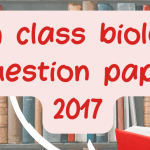Thiruvalluvar University offers a wide range of postgraduate courses, and preparing for the exams can be made easier by going through past question papers. Here are important questions and answers for different subjects in the PG syllabus. Each set of questions is carefully chosen to help students understand core concepts and get a good grip on the material.
English Literature
Question: What is the theme of William Shakespeare’s play “Hamlet”?
Answer: The central theme of “Hamlet” is the struggle between action and inaction, along with themes of revenge, mortality, and the complexity of human emotion.
Question: Explain the concept of metaphysical poetry.
Answer: Metaphysical poetry, prominent in the 17th century, is known for its intellectual wit, complex imagery, and the exploration of abstract themes like love, religion, and death.
Question: What role does the character of Lady Macbeth play in “Macbeth”?
Answer: Lady Macbeth is a driving force behind Macbeth’s rise to power, representing ambition and moral corruption, but later suffers from guilt leading to her downfall.
Question: Discuss the theme of colonialism in Joseph Conrad’s “Heart of Darkness.”
Answer: “Heart of Darkness” critiques the brutal exploitation of colonialism, revealing its dehumanizing effects on both the colonizers and the colonized.
Question: Analyze the use of symbolism in T.S. Eliot’s “The Waste Land.”
Answer: “The Waste Land” uses symbols like the barren land, water, and the Fisher King to depict spiritual desolation and the need for redemption in post-World War I society.
Question: What is the role of fate in Thomas Hardy’s novels?
Answer: Fate in Hardy’s novels often acts as an inevitable force, leading to the downfall of characters despite their efforts, reflecting Hardy’s pessimistic view of life.
Question: How does Virginia Woolf use stream of consciousness in “Mrs. Dalloway”?
Answer: Woolf uses stream of consciousness to delve deep into the characters’ inner thoughts, creating a fluid narrative that mirrors the complexity of human experience.
Question: Discuss the significance of the title “Pride and Prejudice” by Jane Austen.
Answer: The title reflects the novel’s exploration of the characters’ pride in their social status and the prejudices they harbor, particularly in Elizabeth Bennet and Mr. Darcy.
Question: What is the central conflict in George Orwell’s “1984”?
Answer: The central conflict in “1984” is between individual freedom and totalitarian control, depicting a society where personal autonomy is oppressed by an all-seeing government.
Question: Explain the use of irony in Jonathan Swift’s “A Modest Proposal.”
Answer: Swift uses irony in “A Modest Proposal” by presenting a shocking solution to poverty—cannibalism—to criticize the British government’s neglect of the Irish people.
Question: What is the importance of setting in Emily Brontë’s “Wuthering Heights”?
Answer: The wild, untamed setting of the Yorkshire moors mirrors the tumultuous emotions and destructive passions of the characters, especially Heathcliff and Catherine.
Question: How does Charles Dickens portray social class in “Great Expectations”?
Answer: Dickens critiques the rigid class system in “Great Expectations” by showing how wealth and status do not determine one’s true worth, as seen in the journey of Pip.
Question: What is the role of religion in “The Canterbury Tales” by Geoffrey Chaucer?
Answer: Religion is both revered and satirized in “The Canterbury Tales,” with characters like the Parson representing genuine faith, while others, like the Pardoner, embody corruption.
Question: Explain the concept of the Byronic hero with reference to “Don Juan” by Lord Byron.
Answer: The Byronic hero is a flawed, rebellious, and brooding character, often isolated from society. In “Don Juan,” the hero is a charming yet morally complex figure.
Question: What is the role of women in Henrik Ibsen’s “A Doll’s House”?
Answer: Ibsen portrays women’s struggle for independence in a patriarchal society, with Nora Helmer breaking free from societal norms by leaving her husband and children.
Question: Discuss the theme of isolation in Franz Kafka’s “The Metamorphosis.”
Answer: In “The Metamorphosis,” Gregor Samsa’s transformation into a giant insect isolates him from his family and society, symbolizing the alienation of modern life.
Question: What is the significance of the title “Things Fall Apart” by Chinua Achebe?
Answer: The title reflects the breakdown of Igbo society under colonial rule, as well as the personal disintegration of the protagonist, Okonkwo.
Question: How does D.H. Lawrence explore human relationships in “Sons and Lovers”?
Answer: Lawrence delves into the complexities of family, love, and sexual relationships, particularly the influence of a controlling mother on her son’s emotional development.
Question: Explain the use of allegory in George Orwell’s “Animal Farm.”
Answer: “Animal Farm” is an allegory of the Russian Revolution, using animals to represent key figures and events in the rise of Soviet communism and the corruption of power.
Mathematics
Question: Define eigenvalues in linear algebra.
Answer: Eigenvalues are scalars associated with a square matrix, where the matrix times a non-zero vector (the eigenvector) equals the scalar times the vector.
Question: What is the difference between a permutation and a combination?
Answer: A permutation considers the order of items, while a combination does not. For example, ABC and BAC are different permutations but the same combination.
Question: Explain the concept of a limit in calculus.
Answer: A limit represents the value a function approaches as the input approaches a particular point. It’s fundamental in defining derivatives and integrals.
Question: What is the derivative of sin(x)?
Answer: The derivative of sin(x) with respect to x is cos(x).
Question: Define a continuous function.
Answer: A function is continuous if it has no breaks, jumps, or holes in its graph, meaning the function’s value changes smoothly as the input changes.
Question: What is the Pythagorean theorem?
Answer: The Pythagorean theorem states that in a right triangle, the square of the hypotenuse equals the sum of the squares of the other two sides (a² + b² = c²).
Question: What is a matrix in mathematics?
Answer: A matrix is a rectangular array of numbers arranged in rows and columns, used to represent linear transformations and solve systems of equations.
Question: What is the integral of 1/x?
Answer: The integral of 1/x with respect to x is ln|x| + C, where C is the constant of integration.
Question: Define probability.
Answer: Probability is the measure of the likelihood that an event will occur, ranging from 0 (impossible) to 1 (certain).
Question: What is the binomial theorem?
Answer: The binomial theorem describes the expansion of powers of binomials, stating that (a + b)ⁿ can be expanded as a sum of terms involving binomial coefficients.
Question: Explain the concept of a vector.
Answer: A vector is a quantity with both magnitude and direction, represented as an arrow in space or as an ordered pair or triplet of numbers.
Question: What is a real number?
Answer: A real number is any number that can be found on the number line, including both rational numbers (like 2, 1/3) and irrational numbers (like √2, π).
Question: What is the area under a curve?
Answer: The area under a curve, between two points, is the integral of the function that defines the curve over the given interval.
Question: Define a quadratic equation.
Answer: A quadratic equation is a second-degree polynomial equation of the form ax² + bx + c = 0, where a, b, and c are constants.
Question: What is a function in mathematics?
Answer: A function is a relation between a set of inputs and a set of permissible outputs, where each input is related to exactly one output.
Question: What is the law of cosines?
Answer: The law of cosines relates the lengths of the sides of a triangle to the cosine of one of its angles: c² = a² + b² – 2ab cos(C).
Question: Define an imaginary number.
Answer: An imaginary number is a complex number in which the real part is zero, and the number is expressed as a multiple of i, where i² = -1.
Question: What is a differential equation?
Answer: A differential equation is an equation that involves derivatives of a function, expressing how the function changes over time or space.
Question: Explain the concept of a logarithm.
Answer: A logarithm is the inverse operation of exponentiation, meaning log_b(a) is the power to which the base b must be raised to produce a.
Physics
Question: Define Newton’s First Law of Motion.
Answer: Newton’s First Law states that an object will remain at rest or in uniform motion in a straight line unless acted upon by a force.
Question: What is kinetic energy?
Answer: Kinetic energy is the energy an object possesses due to its motion, calculated as ½mv², where m is mass and v is velocity.
Question: Explain the concept of gravity.
Answer: Gravity is a force of attraction between two masses, proportional to the product of their masses and inversely proportional to the square of the distance between them.
Question: What is the law of conservation of energy?
Answer: The law of conservation of energy states that energy cannot be created or destroyed, only transformed from one form to another, maintaining a constant total energy in a closed system.
Question: Define Ohm’s Law.
Answer: Ohm’s Law states that the current flowing through a conductor is directly proportional to the voltage across it and inversely proportional to its resistance (V = IR).
Question: What is the difference between speed and velocity?
Answer: Speed is a scalar quantity representing the rate of motion, while velocity is a vector quantity that includes both speed and direction.
Question: Explain the concept of inertia.
Answer: Inertia is the property of an object to resist changes in its state of motion. A body at rest tends to stay at rest, and a body in motion tends to stay in motion unless acted upon by an external force.
Question: What is Coulomb’s Law?
Answer: Coulomb’s Law describes the force between two charged objects, stating that the force is directly proportional to the product of their charges and inversely proportional to the square of the distance between them.
Question: What is the difference between a scalar and a vector?
Answer: A scalar is a quantity with only magnitude, like temperature or mass, while a vector has both magnitude and direction, like force or velocity.
Question: What is Newton’s Second Law of Motion?
Answer: Newton’s Second Law states that the force acting on an object is equal to the mass of the object times its acceleration (F = ma).
Question: Define the Doppler Effect.
Answer: The Doppler Effect is the change in frequency or wavelength of a wave in relation to an observer moving relative to the source of the wave, commonly observed in sound waves and light.
Question: What is kinetic energy?
Answer: Kinetic energy is the energy an object possesses due to its motion, given by the formula KE = ½mv², where m is mass and v is velocity.
Question: What is the principle of superposition in physics?
Answer: The principle of superposition states that when two or more waves overlap, the resultant wave is the sum of the individual waves at each point in space and time.
Chemistry
Question: What is the difference between an element and a compound?
Answer: An element is a pure substance consisting of only one type of atom, while a compound is made up of two or more different elements chemically bonded together.
Question: What is the pH scale?
Answer: The pH scale measures the acidity or alkalinity of a solution, with 7 being neutral, values less than 7 acidic, and values greater than 7 basic.
Question: Define molarity.
Answer: Molarity is the concentration of a solution expressed as the number of moles of solute per liter of solution (mol/L).
Question: What is a covalent bond?
Answer: A covalent bond is a type of chemical bond where two atoms share one or more pairs of electrons to achieve a stable electron configuration.
Question: What is the law of conservation of mass?
Answer: The law of conservation of mass states that mass cannot be created or destroyed in a chemical reaction, only transformed from one form to another.
Question: What is an oxidation-reduction (redox) reaction?
Answer: A redox reaction involves the transfer of electrons between two species, with one species being oxidized (losing electrons) and the other being reduced (gaining electrons).
Question: What is Avogadro’s number?
Answer: Avogadro’s number is 6.022 x 10²³, representing the number of atoms or molecules in one mole of a substance.
Question: What is the difference between an exothermic and an endothermic reaction?
Answer: An exothermic reaction releases energy, usually in the form of heat, while an endothermic reaction absorbs energy from its surroundings.
Question: What is the periodic law?
Answer: The periodic law states that when elements are arranged by increasing atomic number, there is a periodic repetition of their chemical and physical properties.
Question: Define electronegativity.
Answer: Electronegativity is a measure of an atom’s ability to attract and hold onto electrons within a chemical bond.
Economics
Question: What is GDP?
Answer: GDP (Gross Domestic Product) is the total monetary value of all goods and services produced within a country’s borders in a specific time period.
Question: What is inflation?
Answer: Inflation is the general increase in prices of goods and services in an economy over time, leading to a decrease in purchasing power.
Question: What is fiscal policy?
Answer: Fiscal policy refers to the use of government spending and taxation to influence economic activity, aiming to manage economic growth, reduce unemployment, and control inflation.
Question: What is the law of demand?
Answer: The law of demand states that, all else being equal, as the price of a good decreases, the quantity demanded increases, and vice versa.
Question: Define opportunity cost.
Answer: Opportunity cost is the value of the next best alternative that is foregone when a decision is made to pursue one option over another.
Question: What is monetary policy?
Answer: Monetary policy involves the management of a nation’s money supply and interest rates by its central bank to control inflation and stabilize the economy.
Question: What is a market economy?
Answer: A market economy is an economic system where decisions about production, investment, and distribution are determined by supply and demand with little government intervention.
Question: What is perfect competition?
Answer: Perfect competition is a market structure where numerous small firms compete against each other, products are homogeneous, and no single firm can influence the market price.
Question: What is a monopoly?
Answer: A monopoly exists when a single company or entity controls the entire market for a particular good or service, with no close substitutes available.
Question: Define supply.
Answer: Supply refers to the total amount of a good or service that is available to consumers, typically increasing as the price rises and decreasing as the price falls.
Latest Posts
- Step-by-step guide to download and apply for jee mains admit card 202
- Comprehensive 2025 government holidays and recruitment details for job seekers
- JEE Mains Admit Card 2025: Your Step-by-Step Guide to Downloading the Hall Ticket
- Everything You Need to Know About 2025 Government Holidays Recruitment
- Comprehensive Guide to rrb d group recruitment 2025 – Eligibility, Vacancies, and Application
- Detailed guide to nps trust recruitment 2025 vacancies, eligibility and apply process
- Comprehensive guide to hpcl recruitment 2025 notification, vacancies, and application process
- ignou bed admission 2025 complete recruitment guide with eligibility and process
- Comprehensive Guide to Indian Army Agniveer Recruitment 2025 Notification and Jobs
- Everything You Must Know About CBSE Board Exams 2025 Changes & New Rules






